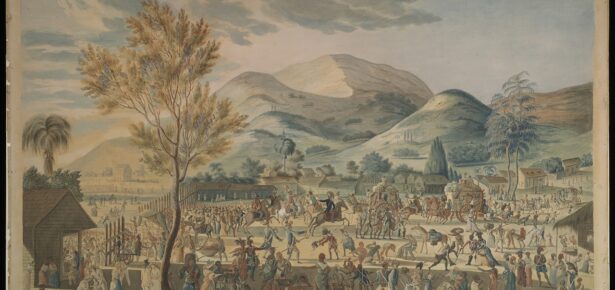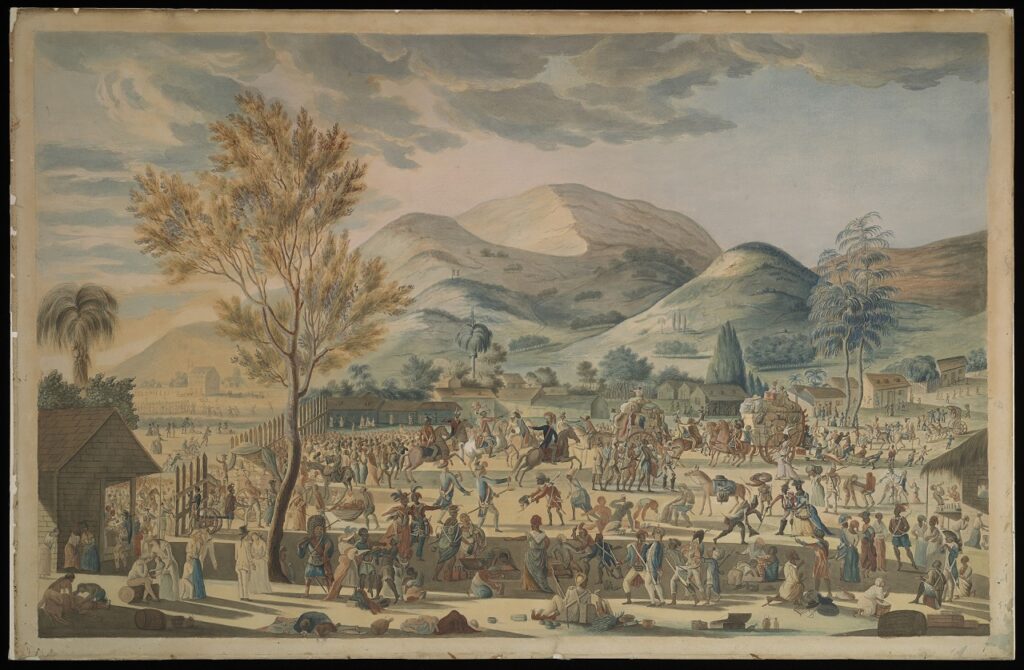
The Haitian Revolution, which began with slave uprisings in the French colony of Saint Domingue in 1791 and resulted in the 1804 declaration of Haitian independence, was a major part of the Age of Revolutions. It was the world’s second major post-colonial revolution, after the US Revolution. In ending slavery, it was the first revolution to live up to the Enlightenment’s abstract ideals of racial equality and freedom. It is still history’s only successful anti-slavery revolution. The Haitian Revolution, with its triumphs as well as its struggles, remains a landmark event for democratic and egalitarian movements worldwide.
A life-or-death struggle against enslavers and colonizers, the Haitian Revolution was also defined by performance in intriguing ways. Rebellious slaves and former masters, for example, conducted acts of performative violence. Political leaders delivered proclamations and accused each other of duplicitous, theatrical behavior. Everyday people performed public scenes designed to elicit sympathy or outrage. In an eighteenth-century world in which public deeds and word of mouth traveled faster and reached more people than print could, people became actors in and spectators of the Haitian Revolution’s grand historical drama.
Contemporary depictions of Haiti’s revolution can give us a sense of how this sometimes looked. In 1793, midway through the struggle, an army of former slaves captured and sacked the colonial city of Cap-Français (modern-day Cap-Haïtien). It was a landmark event in the Haitian Revolution—the capture of the city confirmed that the rebellion was in fact a revolution, and it forced the island’s French leaders to officially free the remainder of the colony’s slaves.
The fall of Cap Français was also, at its core, a deeply theatrical event. An image of the moment, created by French painter J. L. Boquet, depicts the rebels immediately after they had broken into the local theatre and plundered the costumes and props. Dressed up in the stage attire of the colony’s premiere playhouse, the triumphant former slaves parade through the town. It’s a striking scene, an unexpected moment in a time of war. Boquet’s image details the former slaves’ performative rebellion—in fancy dress, they flaunt their newly acquired freedom and privilege. They bow and curtsy, performing the manners of the colonial bourgeoisie. They celebrate, carouse, even perform acts of further violence. The former masters of Saint Domingue, now refugees, stand on the scene’s margins, costumes in tatters and appearing dejected. All this activity swirls around a group of Black horsemen in military costume, an equestrian set piece displaying the revolt’s military successes.
The Haitian Revolution has become, in the most literal way, theatre.

No proof survives that such an event actually happened, but the image implies striking and widely repeated claims about Haiti’s revolution. The revolution was a farce, the image suggests, disorganized banditry easily distracted by shiny objects. It was imitative, motivated not by authentic desires for freedom so much as a greedy desire for others’ privileges. For colonial observers, it seemed at once comedy and tragedy, provoking both horror and humor.
Even as performance could be used to insult the Haitian Revolution, Boquet’s scene also points to performance’s genuinely revolutionary qualities. Revolutionary struggle can be dramatic, and political change, the scene suggests, can involve dramas designed to win audiences’ hearts and minds. Power is projected in performance. Everyday acts and small privileges matter—strutting around in stolen finery can, in fact, be a revolutionary act. Playing a role could, likewise, also have serious social consequences.
While Boquet’s Pillage du Cap represents just one performative moment in the Haitian Revolution, performances of Haiti spread quickly throughout the Atlantic world. Staging Haiti in Nineteenth-Century America: Revolution, Race and Popular Performance explores these performances, introducing a cast of characters that included Haitian revolutionaries, French refugees, and runaway slaves, as well as Black New Yorkers on the London stage and African Americans who emigrated to Haiti. It explores the dignified acts of abolitionist speakers and Haitian monarchs as well as the buffoonery of blackface minstrels in order to sound out the varied ways that Haiti’s revolution was performed in the nineteenth century.
Theatrical genres ranging from sentimental comedy to opera, from blackface song to Shakespearean burlesque, show us how the stage took up Haitian themes and characters. Acts staged outside the playhouse—graduation speeches, abolitionist oratory, and even royal processions—also reveal Haiti as a deeply contested but also deeply meaningful part of American popular culture. Sometimes reviled, sometimes admired, Haiti became an emblematic stage for the performance of freedom, independence, and racial equality in the nineteenth century. In the process, Haiti’s revolution also posed profound questions about our politics and our lives. Staging Haiti in Nineteenth-Century America ultimately asks such questions: who acts, and how? How do dramatic genres shape historical events, and how do stage characters influence how we see other people? How do we comprehend spectacular events in world history, and how do we understand ourselves as spectators to such events? The answers, particularly in the charged example of Haitian revolution, are not simple, but these questions might move us toward a greater understanding of Haiti’s impact on our sense of identity, our ideas about revolutionary change, and our understanding of popular culture.
Latest Comments
Have your say!